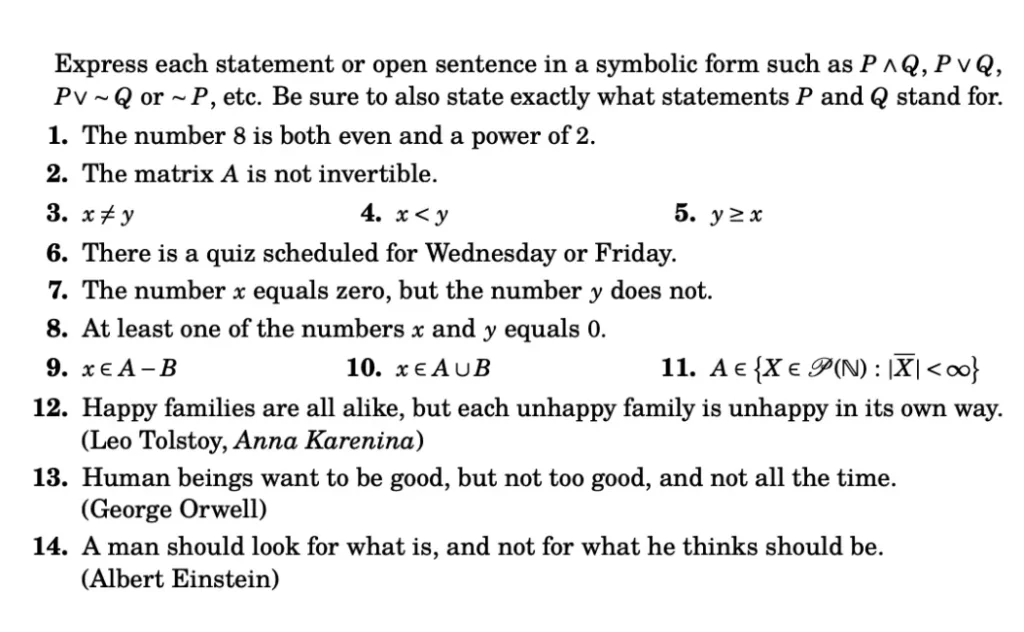Homework Help: Questions and Answers: Express each statement or open sentence in a symbolic form such as P∧Q, P∨Q, P∨∼Q or ∼P, etc. Be sure to also state exactly what statements P and Q stand for.

- The number 8 is both even and a power of 2.
- The matrix A is not invertible.
- x = y
- x < y
- y ≥ x
- There is a quiz scheduled for Wednesday or Friday.
- The number x equals zero, but the number y does not.
- At least one of the numbers x and y equals 0.
- x ∈ A−B
- x ∈ A∪B
- A ∈ {X∈P(N) : ∣x̄∣ <∞}
- Happy families are all alike, but each unhappy family is unhappy in its own way. (Leo Tolstoy, Anna Karenina)
- Human beings want to be good, but not too good, and not all the time. (George Orwell)
- A man should look for what is, and not for what he thinks should be. (Albert Einstein)
Answer:
Let’s solve these problems step by step.
1. The number 8 is both even and a power of 2.
- Statement P: 8 is even.
- Statement Q: 8 is a power of 2.
- Symbolic Form: P ∧ Q
2. The matrix A is not invertible.
- Statement P: The matrix A is invertible.
- Symbolic Form: ¬P
3. x / y
- This is already in symbolic form. No further conversion is needed.
4. x < y
- This is also already in symbolic form.
5. y ≥ x
- This is already in symbolic form.
6. There is a quiz scheduled for Wednesday or Friday.
- Statement P: The quiz is scheduled for Wednesday.
- Statement Q: The quiz is scheduled for Friday.
- Symbolic Form: P ∨ Q
7. The number x equals zero, but the number y does not.
- Statement P: x = 0
- Statement Q: y ≠ 0
- Symbolic Form: P ∧ Q
8. At least one of the numbers x and y equals 0.
- Statement P: x = 0
- Statement Q: y = 0
- Symbolic Form: P ∨ Q
9. x ∈ A – B
- This is already in symbolic form, where A – B represents the set difference.
10. x ∈ A ∪ B
- This is already in symbolic form, where A ∪ B represents the union of sets A and B.
11. A ∈ {X ∈ P(N) : ∣x̄∣ < ∞}
- This is already in symbolic form. It represents that set A belongs to a particular collection of sets.
12. Happy families are all alike, but each unhappy family is unhappy in its own way.
- Statement P: Happy families are all alike.
- Statement Q: Each unhappy family is unhappy in its own way.
- Symbolic Form: P ∧ Q
13. Human beings want to be good, but not too good, and not all the time.
- Statement P: Human beings want to be good.
- Statement Q: Human beings do not want to be too good.
- Statement R: Human beings do not want to be good all the time.
- Symbolic Form: P ∧ ¬Q ∧ ¬R
14. A man should look for what is, and not for what he thinks should be.
- Statement P: A man should look for what is.
- Statement Q: A man should not look for what he thinks should be.
- Symbolic Form: P ∧ ¬Q
Learn More: Homework Help
Q. Which of the following best describes the function of an IDMS server?
Q. What is the purpose of the nn module in PyTorch?
Q. What is the primary purpose of the nn module in PyTorch?
Q. Which of the following best describes the purpose of a QR code?

